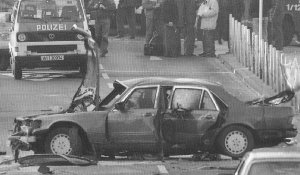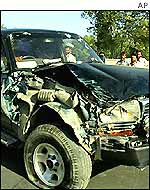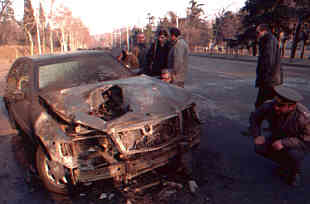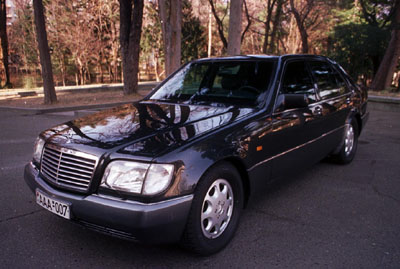  |
|
|
Surveillance
Detection Program
|
 |
The
type of road the executive travels has a lot to
do with the type of attack the terrorist will mount,
and in fact it may have a lot to do with it, if
the executive is picked as the final target. Special
emphasis needs to be placed on locations along
the route to and from work called choke points.
Security personnel and managers need to know:
*
What a choke point is
* What, if anything, can be done to avoid it
* What to do if we're in it
A choke point is a location near home or office, that due to environmental factors you cannot avoid. Places like:
*
Narrow roads
* Slow driving areas
* Blind spots in road
At choke points everyone involved in the protection of the executive and/or the executive if they drive themselves, should be looking for changes in the environment around the choke point. They should know:
*
What cars should be there?
* What people should be there?
The above should not be a guess. A plan should consist of first knowing the location of all choke points. The driver or the executive should know exactly where he is. If the executive does not understand the idea of choke points, or worse does not care about choke points, then a member of the security team should do the work for the executive. Then the executive needs to be briefed and told what it is he should be looking for, and anything unusual —ANYTHING— must be reported and action taken.
If at all possible, a group of people or a person should go in advance of the executive and look for problems, and with a clear understanding of what it is they should be looking for. Knowing what to look for is not complicated.
Remember
the problem of the Herrhausen attack? The protection
team was organized and ready for the classic vehicle
ambush and they got a roadside bomb. An advance can
mean only a minute in advance. Either by motorcycle
or by car, someone goes a minute or so in front
of the executive and scouts the area. There should
be communications from the advance vehicle to the
principal car. If at all possible the executives
car should not drive through a choke point unless
the choke point has been previously checked. The
advance person is looking for signs of an ambush.
This was done in the Herrhausen incident but they
were looking for the wrong thing.
The advance person must know what to look for. Looking not only for people
but also for things. In the Herrhausen incident it was a bicycle. What
are the signs of an ambush? They can be anything that will make the car
slow down. If the threat is assassination it will be something that you
drive by. Is it complicated and time consuming? Yes. But what are the alternatives?
The only chance Herrhausen had was counter surveillance— the detection
of the signs of an ambush in a choke point.

![]() The
recent assassination of Vice-President Haji Abdul
Qadir of Afghanistan has highlighted security concerns
and fears of possible rivalries between powerful
figures in the government.
The
recent assassination of Vice-President Haji Abdul
Qadir of Afghanistan has highlighted security concerns
and fears of possible rivalries between powerful
figures in the government.
As you approach or leave the home and office area the options are less. Defensive measures should concentrate on the following:
*
In a high risk environment you must change your
routes, and developing alternate routes that begin
as close as possible to the individual's home.
* If there is limited access in and out of the area of work and home meticulous
advance reconnaissance is necessary of all roads that, for whatever reason,
the individual must unavoidably pass.
* All terrorist attacks are preceded by surveillance. These surveillances
are not that sophisticated that the average person with some reasonable
training could not spot them.
The
key to an effective surveillance awareness program
is alertness. The philosophy should be adopted
that once is happenstance, twice is coincidence,
and three times is enemy action. Sir Geoffrey Jackson,
who was kidnapped by terrorists, describes his
awareness of their surveillance in this manner:
"When, after a relatively quiet life, nocturnal calls begin to proliferate,
when one's hitherto pleasantly solidarity walks along beaches and sand dunes
and in pine forests begin to bristle with horizon-marching silhouettes and sudden
encounters with the young in unlikely trio formation, when one's golf game --
not only one's own -- regularly begins to be interrupted by casual young spectators
on remote fairways, where for the third time one's path is crossed by professional
violence literally at one's door step -- by this time the least perceptive of
mortals begins to grasp that, however much the world around him may be changing,
his own private world is changing still more."
The above is an eloquent description of surveillance and awareness of a changing environment.
The level of awareness must be raised to a point where:
*
Strange vehicles parked near the residence or place
of employment are noticed and reported to authorities.
* People standing, walking, or sitting in cars near the residence or place
of employment must be noticed.
* An individual can recognize that he is being followed. If they do feel
they are being followed, they can simply drive around the block and notice
if the suspected vehicle is still there.
Many people associate surveillance detection with watching for someone following you on foot. Although it is a good idea to do that, it is as important to watch for cars, and more important to watch for signs of an ambush as the car reaches the home or office.

![]() In
1998 Georgian President Eduard Shervardnadze survived
a missile attack when more than 10 gunmen opened
fire upon his armored Mercedes using automatic
rifles and grenades.
In
1998 Georgian President Eduard Shervardnadze survived
a missile attack when more than 10 gunmen opened
fire upon his armored Mercedes using automatic
rifles and grenades.
The question is—do you have the executives responsible for their own surveillance detection? Do you have the driver responsible? A bodyguard? Or do you have an individual whose responsibility it is to watch for surveillances and ambushes? If the plan is to have someone whose job it is to look for surveillances, and since most attacks happen near the office and the home, it makes sense that a person is stationed near the executives home and place of business. There is one particular type of assassination that requires a surveillance detection program, and that is roadside bombs. Roadside bombs require someone looking at choke points along the route traveled. Those choke points need to be watched as closely as the area around the home and office. There is no other alternative. In the Herrhausen incident no driving maneuver or armored car would have prevented the incident.
If the situation warrants a complete surveillance detection program, the first thing that needs to be done is the collection of information. This information must be analyzed, and then distributed. The steps are as follows:
1.
Someone determines what is normal in the area around
the home and office and choke points.
2. There is constant examination of these areas.
3. Compare what is found by examining the environment (step 2) to what
is normal (step 1). This can be done by computer.
4. Analyzing the information in (Step 3).
5. If there is a change in the normal environment, examine in detail what
it is, why it is there.
6. Tell the people who are in that area. This is done simultaneously with
step 5.
7. Take some action.
STEP ONE
Someone who knows what to look for determines what is normal. There should be some plan that assures that all the areas around the home and office have been mapped to determine the "norm". Also if more than one person needs protection and there is more than one person collecting data, the people collecting the data need to learn how to describe what they are looking at. It is common for two people to look at the same thing and describe it in a different way. Companies working in a high risk area have developed counter surveillance reporting forms, and assure that the people are recording everything the same way.
STEP TWO
Once the norm is decided, constant observation of these areas is required. The information recorded (Step 1 and Step 2) includes not only the area around the home, but also choke points.
STEPS THREE AND FOUR
Analysis of the data. Once the data is collected the information needs to be looked at and examined. This is easily done with a computer. There are programs available that can look for a surveillance. The need for a computer depends on the amount of information you recorded. If you have ten executives that are working in a high risk area then it is close to impossible to do all that without the use of a computer.
STEP FIVE
If a change in the environment occurs, examine it immediately. Find out what it is. If the threat is assassination it should be done as quickly as possible.
STEP SIX
Distributing the information. Once the information has been collected and analyzed it needs to go back out to those in the field. All this may sound complicated, but it is not. If there is a surveillance detection person who is assigned to an area, he usually can do all the steps listed above in his mind. He will immediately recognize a problem and solve it. What's important is he knows what to look for and what to do if he finds it.

President
of Georgia Eduard Shevardnadze uses armored car "Mercedes
600".
Germany and Daimler-Benz gave Georgian President the new armored Mercedes
limousine to replace one damaged during an assassination attempt on 9th
of
February
1998 in the Georgian capital, Tbilisi. Mr.Shevardnadze's old limousine
was also a
gift from Germany and the carmaker.
|
|
Accelerated Promotions |
|
Spy
Gear | Gas
Masks | Night Vision Equipment
Spy Equipment Catalog
Click Here for Advanced Counter-Surveillance
Equipment
Patriot Act Intro
|
USA Patriot Act | Carnivore
| Magic Lantern
| Bibliography
| surveillance devices
| surveillance detection
| counter surveillance
| two way radio |
| telephone security
| personal security
| night vision optics
| hidden cameras
| armored vehicles |
| HOME
| astrology
| auctions
| cape coral
| cars
| computers
| consumer electronics
| credit cards
| employment
| entertainment
| financial strategies
| fort myers
| free
| loans
| marketing
| pasco
| memory
| personals
| ram memory
| real estate
| ron paul wiki project
| site map
| spy gear
| survival
|
|
Copyright © 2002-2014 Accelerated Global
All Rights Reserved
Spy
Gear
SURVEILLANCE
DEVICES
SURVEILLANCE DETECTION
COUNTER SURVEILLANCE
TWO-WAY RADIO
TELEPHONE SECURITY
PERSONAL SECURITY
NIGHT VISION OPTICS
HIDDEN CAMERAS
ARMORED VEHICLES
BULLET PROOF VESTS
Sections
SPY GEAR INDEX
HELLO DIRECT
USA PATRIOT ACT INTRO
USA PATROIT ACT
CARNIVORE
MAGIC LANTERN
BIBLIOGRAPHY